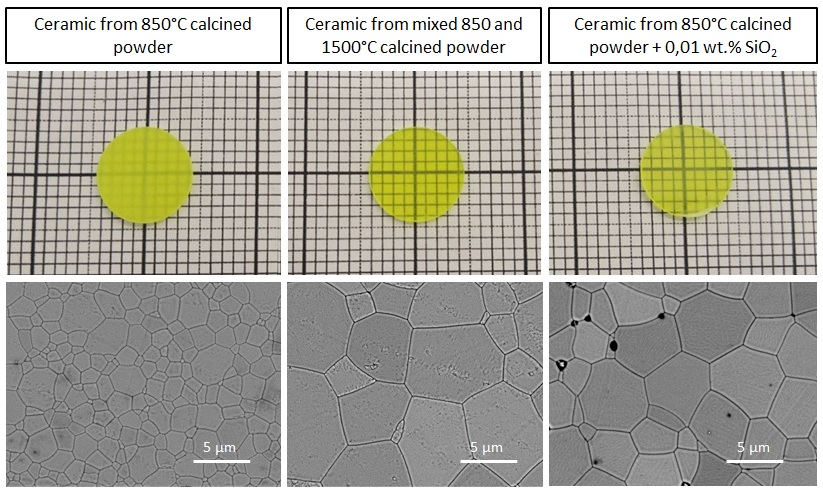Nanosystems: Phys. Chem. Math., 2024, 15 (6), 893–901
Effect of nanostructuring of coprecipitated precursors on the morphology and scintillation properties of multication ceramics with a garnet structure
Valentina G. Smyslova – National Research Center “Kurchatov Institute”, Moscow, 123182, Russian Federation; smyslovavg@gmail.com
Vasiliy M. Retivov – National Research Center “Kurchatov Institute”, Moscow, 123182, Russian Federation; vasilii_retivov@mail.ru
Valery V. Dubov – National Research Center “Kurchatov Institute”, Moscow, 123182, Russian Federation; valery_dubov@mail.ru
Lidia V. Ermakova – National Research Center “Kurchatov Institute”, Moscow, 123182, Russian Federation; ermakova_lv@nrcki.ru
Vladimir K. Ivanov – Kurnakov Institute of General and Inorganic Chemistry, Moscow, 119071, Russian Federation; van10@mail.ru
Petr V. Karpyuk – National Research Center “Kurchatov Institute”, Moscow, 123182, Russian Federation; karpyuk_pv@nrcki.ru
Ilya Yu. Komendo – National Research Center “Kurchatov Institute”, Moscow, 123182, Russian Federation; komendo_iyu@nrcki.ru
Daria E. Lelekova – National Research Center “Kurchatov Institute”, Moscow, 123182, Russian Federation; daria_kyznecova@inbox.ru
Vitaly A. Mechinsky – National Research Center “Kurchatov Institute”, Moscow, 123182, Russian Federation; “Institute for Nuclear Problems” of the Belarusian State University, Minsk, 220030, Republic of Belarus; vitaly.mechinsky@gmail.com
Andrey N. Vasil’ev – Skobeltsyn Institute of Nuclear Physics, Moscow State University, Moscow, 119234, Russian Federation; anv@sinp.msu.ru
Artemii S. Ilyushin – Skobeltsyn Institute of Nuclear Physics, Moscow State University, Moscow, 119234, Russian Federation; artyom2833@mail.ru
Petr S. Sokolov – National Research Center “Kurchatov Institute”, Moscow, 123182, Russian Federation; sokolov_ps@nrcki.ru
Mikhail V. Korzhik – National Research Center “Kurchatov Institute”, Moscow, 123182, Russian Federation; “Institute for Nuclear Problems” of the Belarusian State University, Minsk, 220030, Republic of Belarus; korjikmikhail@gmail.com
Corresponding author: V. G. Smyslova, smyslovavg@gmail.com, smyslova vg@nrcki.ru
PACS 81.20.Ev; 82.40.Qt
DOI 10.17586/2220-8054-2024-15-6-893-901
ABSTRACT Single-phase polycrystalline samples of the (Gd,Y)3Al2Ga3O12:Ce,Tb composition with a garnet structural type were obtained. Using various approaches to the preparation of the initial powders of hydroxycarbonate precursors and compaction methods, the grain size of the ceramics was varied. The scanning electron microscopy method was used to establish the features of the microstructure of the initial powders with different processing temperatures and the microstructure of the resulting ceramics. It is shown that an increase in the grain size of the ceramics and a decrease in the residual porosity gives a noticeable increase in optical transparency in the visible region of the spectrum, in which Ce3+ and Tb3+ ions emit during scintillation. The effect of intergrain boundaries of the ceramics on the diffusion features of nonequilibrium carriers, electrons and holes, as well as excitons formed during the absorption of ionizing radiation on the scintillation yield and energy resolution is considered.
KEYWORDS precursor, ceramics, garnet, microstructure, scintillation, light yield.
ACKNOWLEDGEMENTS Calculations of the dependence of the fluctuation contribution to the energy resolution of a crystalline scintillator on the grain size, the development of a scheme for the recombination of electrons and holes with the formation of charge-transfer excitons in a homogeneous crystal and in ceramics were obtained with the financial support of the Russian Federation represented by the Ministry of Education and Science of Russia, agreement No. 075-15-2021-1353 dated October 12, 2021. Research was done using equipment of “Research Chemical and Analytical Center NRC “Kurchatov Institute” Shared Research Facilities.
FOR CITATION Smyslova V.G., Retivov V.M., Dubov V.V., Ermakova L.V., Ivanov V.K., Karpyuk P.V., Komendo I.Yu., Lelekova D.E., Mechinsky V.A., Vasil’ev A.N., Ilyushin A.S., Sokolov P.S., Korzhik M.V. Effect of nanostructuring of coprecipitated precursors on the morphology and scintillation properties of multication ceramics with a garnet structure. Nanosystems: Phys. Chem. Math., 2024, 15 (6), 893–901.
[In Russian] В.Г. Смыслова, В.М. Ретивов, В.В. Дубов, Л.В. Ермакова, В.К. Иванов, П. В. Карпюк, И.Ю. Комендо, Д.Е. Лелекова, В.А. Мечинский, А.Н. Васильев, А.С. Ильюшин, П.С. Соколов, М.В. Коржик
Влияние наноструктурирования соосажденных прекурсоров на морфологию и сцинтилляционные свойства многокатионной керамики со структурой граната
АННОТАЦИЯ Получены однофазные поликристаллические образцы состава (Gd,Y)3Al2Ga3O12:Ce,Tb со структурным типом граната. Используя различные подходы к подготовке исходных порошков гидроксокарбонатных прекурсоров и методов формования, производили варьирование размера зерна керамики. Методом сканирующей электронной микроскопии были установлены особенности микроструктуры исходных порошков с разной температурой обработки и микроструктуры получаемой керамики. Показано, что увеличение размера зерна керамики и снижение остаточной пористости даёт заметный прирост оптической прозрачности в видимой области спектра, в которой излучают ионы Ce3+ и Tb3+ в процессе сцинтилляции. Рассмотрено влияние межзёренных границ керамики на особенности диффузии неравновесных носителей, электронов и дырок, а также экситонов, образующихся при поглощении ионизирующего излучения на выход сцинтилляций и энергетическое разрешение.
КЛЮЧЕВЫЕ СЛОВА прекурсор, керамика, гранат, микроструктура, сцинтилляция, световыход
